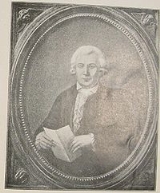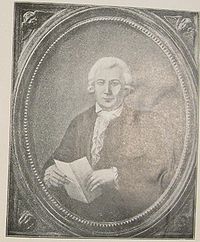
Jan Dekert
Encyclopedia


Bourgeoisie
In sociology and political science, bourgeoisie describes a range of groups across history. In the Western world, between the late 18th century and the present day, the bourgeoisie is a social class "characterized by their ownership of capital and their related culture." A member of the...
in the Polish-Lithuanian Commonwealth
Polish-Lithuanian Commonwealth
The Polish–Lithuanian Commonwealth was a dualistic state of Poland and Lithuania ruled by a common monarch. It was the largest and one of the most populous countries of 16th- and 17th‑century Europe with some and a multi-ethnic population of 11 million at its peak in the early 17th century...
, however he was also known as an opponent of Jewish merchants.
He was born in the village of Bledzew
Bledzew
Bledzew is a village in Międzyrzecz County, Lubusz Voivodeship, in western Poland. It is the seat of the gmina called Gmina Bledzew. It lies on the western rim of the Greater Poland historic region, left of the Obra river, approximately north-west of Międzyrzecz, south-east of Gorzów...
. He started out as a clerk in a cloth store in Warsaw
Warsaw
Warsaw is the capital and largest city of Poland. It is located on the Vistula River, roughly from the Baltic Sea and from the Carpathian Mountains. Its population in 2010 was estimated at 1,716,855 residents with a greater metropolitan area of 2,631,902 residents, making Warsaw the 10th most...
. He gathered enough savings to become a cofounder of the Company of Woolen Manufacture in 1766. In 1775 the Sejm
Sejm
The Sejm is the lower house of the Polish parliament. The Sejm is made up of 460 deputies, or Poseł in Polish . It is elected by universal ballot and is presided over by a speaker called the Marshal of the Sejm ....
granted him a request to buy landed estates (a privilege usually restricted only to the nobility). In 1776 he leased from Polish Treasury the Tobacco Monopoly; ten years later, in 1786, he leased the Theatre in Warsaw. He became Alderman
Alderman
An alderman is a member of a municipal assembly or council in many jurisdictions founded upon English law. The term may be titular, denoting a high-ranking member of a borough or county council, a council member chosen by the elected members themselves rather than by popular vote, or a council...
of Warsaw in 1769 and also served in the same position for the Confraternity of Merchants from 1771 to 1785.
He was elected a deputy to Sejm
Sejm
The Sejm is the lower house of the Polish parliament. The Sejm is made up of 460 deputies, or Poseł in Polish . It is elected by universal ballot and is presided over by a speaker called the Marshal of the Sejm ....
s of 1784 and 1786, as well as to the Great Sejm
Great Sejm
The Great Sejm, also known as the Four-Year Sejm was a Sejm of the Polish-Lithuanian Commonwealth that was held in Warsaw, beginning in 1788...
(1788-1892) as the representative of Warsaw. In the meantime, in 1789, he was elected mayor of Warsaw; he would be reelected in 1790 (as a mayor of Warsaw, he replaced Wojciech Lobert, and would be proceeded by Józef Michał Łukasiewicz). During the Great Sejm, he organized the confederation of 141 cities and towns and was at the forefront of demanding the representations and enfranchisement of the burghers in the Sejm; notably, he helped organize the Black Procession
Black Procession
Black procession refers to a demonstration held by burghers in Polish-Lithuanian Commonwealth's capital of Warsaw on 2 December 1789, during the Great Sejm. It vastly constributed to the passage of a belated major urban reform....
on December 2, 1789 (a march of burghers who delivered a petition to the king).
He was a vocal critic of Jews, accusing them of unfair competition.
He spend much of his fortune on political activism, according to some sources, he was nearly bankrupt by the time of his death. He was last seen in public on 31 April 1791. He died on 4 October 1790 in Warsaw. He was buried in the Warsaw Cathedral
Warsaw Cathedral
Warsaw Cathedral can refer to:* St. John's Cathedral, Warsaw* Field Cathedral of the Polish ArmyFormer:* Alexander Nevsky Cathedral, Warsaw...
, and his large funeral was paid for by the City of Warsaw.
He died before the Free Royal Cities Act
Free Royal Cities Act
The Free Royal Cities Act was an act adopted by the Four-Year Sejm of the Polish-Lithuanian Commonwealth on April 18, 1791, in the run-up to the adoption of the...
, enfranchising burghers, was passed next year as one of the reforms of the Great Sejm, next to the Constitution of the 3rd May.
He was the father of bishop Jan Dekert.
Legacy
Jan Dekert is one of the characters on Jan MatejkoJan Matejko
Jan Matejko was a Polish painter known for paintings of notable historical Polish political and military events. His most famous works include oil on canvas paintings like Battle of Grunwald, paintings of numerous other battles and court scenes, and a gallery of Polish kings...
's painting of the "Adoption of the Polish Constitution of May 3, 1791".
The north side of the Old Town Market Place, Warsaw
Old Town Market Place, Warsaw
Warsaw's Old Town Market Place is the center and oldest part of the Old Town of Warsaw, capital of Poland. Immediately after the Warsaw Uprising, it was systematically blown up by the German Army...
is named after him.
Further reading
- Krystyna Zienkowska, Jan Dekert, PIW, 1982

